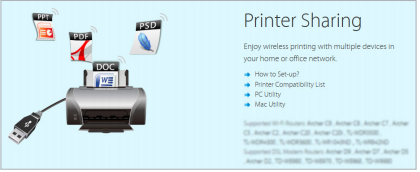StarTech.com 1 Port USB Wireless N Network Print Server with 10/100 Mbps Ethernet Port - 802.11 b/g/n - Wireless USB 2.0 Print Server. Network Connection: USB 2.0 RJ45 (10/100 Ethernet) Wireless Ethernet Network Speed: 10/100Mbps Printer Connection: 1 - USB A (4 pin) Female 1 - RJ-45 Female 1 - Wireless N (IEEE 802.11n) Protocols: TCP/IP (LDP / LPR Printer Port) IPX NetBEUI AppleTalk SNMP SMB. HP J7951G Wireless Print Server. Network Connection: 802.11b / g, RJ45 Printer Connection: USB 2.0 Protocols: TCP/IP, IPX/SPX direct mode, AppleTalk, IP Direct Mode, LPD printing, Telnet, SLP, IGMP, BOOTP/DHCP, WINS, SNMP, HTTP, Auto-IP, Apple Rendezvous compatible (Mac OS 10.2.6 and later) Operating Systems Supported: Microsoft Windows 98, Me, NT 4.02, 2000, XP, XP 64-Bit, Server 2003. The Hawking HMPS1A Wireless USB Print Server lets you connect and share your multi-function printers, scanners and other USB devices with multiple computers in your network, wired or wirelessly. The HMPS1A saves space and removes clusters from having USB devices (printers, hard drives, etc) at home or office. Note: For Windows and Mac (up to Mac OS10.14), any printer will work using the.
USB port types and names
USB (Universal Serial Bus) is an industry standard for connecting computers and other devices. It's available with many types of ports, and each type has a unique shape. On Mac computers, USB is available with these ports, depending on your Mac model:
USB-A
Type USB-A ports are commonly called USB, USB 2, or USB 3 ports, depending on the USB specification they support. They aren't reversible, so a USB-A connector plugs into the port only when oriented correctly.
USB-C
Type USB-C ports are available as either standard USB-C ports or Thunderbolt 3 ports that also support USB-C connections. They both look the same, and the connector plugs into the port in either orientation.
Learn more about identifying the ports on your Mac, as well as the adapters and cables you can use to connect older devices to type USB-C ports.
USB specifications
USB specifications are important primarily when you want the most speed and power for your USB device, or your device needs more power or is using too much power. Every USB port supports a particular USB specification, which determines the port's maximum>USB specifications on MacData transferPowerUSB 3.1 Gen 2
Also known as USB 3.2 Gen 2
Up to 10 GbpsUp to 15W at 5VUSB 3.1 Gen 1
Also known as USB 3.2 Gen 1 or USB 3
Up to 5 GbpsUp to 900 mA at 5VUSB 2.0
Up to 480 MbpsUp to 500 mA at 5VUSB 1.1
Up to 12 MbpsUp to 500 mA at 5V
To learn which specification is supported by a type USB-A or type USB-C port on your Mac model:
- Choose Apple menu > About This Mac, click Support, then click Specifications.
- Check the System Information app for more details, including about USB devices connected to USB ports on your Mac. Select USB in the sidebar, then select a USB bus on the right.
Get the best performance from your USB devices


USB specifications all work with each other, but speed and power are limited by the cable or device that uses the earliest specification. For example, if you connect a USB 3 device to USB 2 port, your device is limited to USB 2 speeds, and it can't draw more power from the port than can be delivered over USB 2. In other words, to get the best performance, make sure that the USB port on your Mac and the USB cable to your device meet or exceed the USB specification of the device itself.
Usb Print Server For Mac Catalina

If your Mac doesn't recognize a USB device after you plug it into your Mac:
- Check all connections: Unplug the device from your Mac, then plug it back in, and make sure that all cables and adapters are securely connected at both ends. Test with another cable or adapter, if available.
- Plug the device directly into your Mac instead of a USB hub or other device, and if necessary test with a different USB port on your Mac or device.
- Some devices need their own software, such as drivers or firmware. Others work without additional software. Check with the maker of your device, and install all available Apple software updates as well.
- If your device came with an AC power adapter, use it. Some devices can be powered by the USB port on your Mac. Others need more power than your Mac can provide.
- Restart your Mac.
Wireless To Usb Print Server
Learn more
Print Server For Usb Printer
- USB 3 devices can create wireless interference that affects Wi-Fi and Bluetooth devices. Learn how to resolve Wi-Fi and Bluetooth issues caused by wireless interference.
- Mac notebook computers with USB-C or Thunderbolt 3 can charge over that port using a compatible USB-C power adapter and cable.
